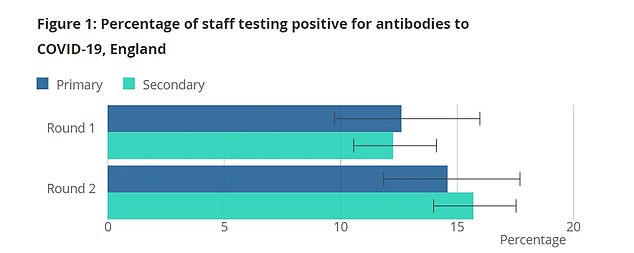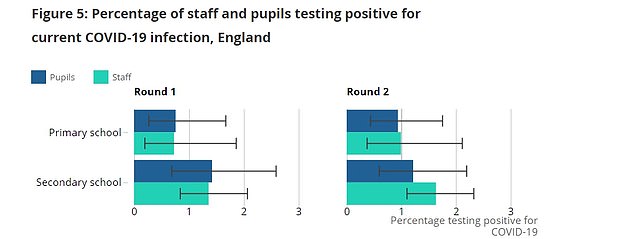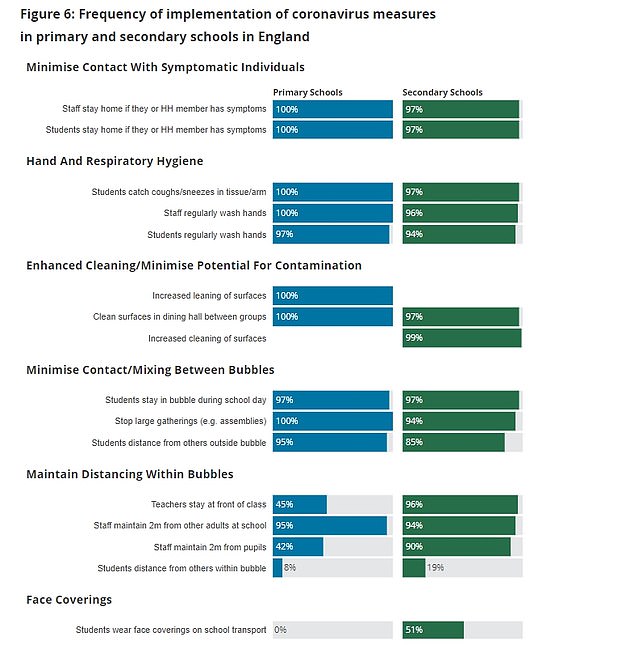Teachers are NOT more at risk of catching Covid: ONS study finds similar rates of Covid antibodies in school staff and the general public
- Office for National Statistics study looked at 120 schools in England in December
- About 14.6% of primary and 15.7% of secondary staff tested positive for proteins
- This was lower than 18.2% of adults in wider community who had the antibodies
Teachers are no more likely to catch coronavirus than their peers, an official report has confirmed amid concerns about schools reopening next week.
The Office for National Statistics study of 120 schools in England at the start of the second wave found similar rates of Covid antibodies among staff and the general public.
About 14.6 per cent of primary staff and 15.7 per cent of secondary staff tested positive for the proteins – which signal prior infection – in the first week of December, compared to 18.2 per cent in the wider community.
Researchers behind the study said it ‘indicates that staff and students in schools are not at a significantly higher risk of Covid-19 than the general population’.
All schools in England are due to reopen next Monday as part of Boris Johnson’s lockdown-easing plans after shuttering their doors more than two months ago.
But teaching unions have demanded a phased return instead, warning there could be a ‘big bang’ of infections when millions of pupils pour back into classrooms.
Dr Shamez Ladhani, a consultant paediatrician at Public Health England and the study’s chief investigator, said the benefits of reopening schools on March 8 ‘far outweigh the risk’ of Covid to teachers, even though ‘the risk is not zero’.
Prevalence of antibodies during the first round of the study in November, when schools remained open during the second national lockdown, was about 12.5 per cent in both the working-age population and among teachers.
Antibodies were even less common among pupils, with just 7.6 per cent of primary and 11 per cent of secondary students testing positive in November. The report did not include pupil data for December.

About 14.6 per cent of primary staff and 15.7 per cent of secondary staff tested positive for antibodies – which signal prior infection – in the first week of December, compared to 18.2 per cent in the wider community. Prevalence of antibodies during the first round of the study in November was about 12.5 per cent in both the working-age population and among teachers

Antibodies were even less common among pupils, with just 7.6 per cent of primary and 11 per cent of secondary students testing positive in November, the most recent period the study covered

Just 0.94 per cent of primary school pupils tested positive through PCR and 0.99 per cent of staff. The rates were slightly higher in secondary schools at 1.22 and 1.64 per cent

The study, which also involved Public Health England and the London School of Hygiene & Tropical Medicine, credited the low rates to most schools stringently following Covid measures
Dr Ladhani added: ‘Where we’re at now is really an amazing place to be for reopening schools in the right way.
‘The country is in lockdown, infection rates are falling rapidly, community transmission is going to be very low when they [staff and pupils] go back to school.
‘We’re in an environment where the risk of infection coming into schools is very low and at the same time testing is being done, which means every child being tested two to four times a week.
‘If you cut down those infected staff and students going in to school [and spreading the disease] then you dramatically reduce the risk.
‘It would be naïve to think going to school is as safe as staying at home, but by doing this the benefits far outweigh the risks, but the risks are not zero.’
A total of 7,089 students and 5,114 staff in 121 schools in 15 areas in England were tested during the most recent phase of the study.
They were swabbed at least once for either current infection using a PCR test or tested for antibodies, which show if a person has previously been infected, using a blood test.
It found that rates of current infection were not higher in schools than in the wider community. A total of 0.94 per cent of primary school pupils tested positive through PCR and 0.99 per cent of staff.
The rates were slightly higher in secondary schools at 1.22 and 1.64 per cent. The ONS estimates that for the population of England as a whole at that time, about 1.04 per cent of people had the virus.
The study, which also involved Public Health England and the London School of Hygiene & Tropical Medicine, credited the low rates to most schools stringently following Covid measures.
Of 105 schools in which Covid protocols were analysed, ‘almost all’ primary schools followed the Government’s most important rules, including isolating infected staff and pupils and their contacts, enhanced cleaning and social distancing.
The researchers said the enhanced testing being brought into schools from next Monday will make schools even more Covid secure.
Secondary school pupils will be tested twice-weekly, with the first three at school before they start taking them at home.
Whole families with primary and secondary school-age children, as well as people in their childcare and support bubbles, will also be offered rapid lateral flow tests at least twice a week.
The kits will be provided regardless of whether anyone in the family has symptoms of Coronavirus and will be available from tomorrow.
They will also be offered twice a week to adults working with schools, including bus drivers and after-school club leaders.
They can be ordered and collected from more than 500 local sites or administered through workplace testing programmes.
All members of households with children attending school or sixth form college will be encouraged to begin regular twice-weekly testing, although the tests will not be compulsory. A confirmatory PCR test will be required if a lateral flow test comes back positive.
Professor Sinéad Langan, co-chief investigator of the study at LSHTM, said: ‘Schools and their staff have made a huge effort to protect themselves and their students by implementing Covid-19 control measures to try and stop infection entering the school site, and reduce on-site transmission.
‘These preliminary findings suggest participating school staff were not at significantly higher risk of infection than working age adults in the wider community.’
Professor Langan added: ‘With every round of this study we are finding out more about Covid-19 infection in schools, and how that links with transmission in the local community.
‘These findings show that some individuals attending schools have COVID-19 infections and therefore there is potential for transmission. However, it is still hard to say whether this infection is occurring within the schools or in the wider community.
‘More investigation is needed to measure the tangible effect of school control measures implementations. The effect of the recently introduced twice weekly home tests on infection prevalence within schools should also be carefully evaluated.’
Independent scientists reacting to the findings described them as ‘reassuring’.
Professor Russell Viner, an expert in child health at University College London, said: ‘These are very useful data from an overall high quality study.
‘In essence the study suggests that school levels of infection in late 2020 were similar to community levels for both adults and children.
‘This suggests that schools are not amplifiers of infection, as some have feared, but that school infections largely reflect community virus levels.
‘Unfortunately the study as set up cannot be directly informative about transmission between children and from children to staff.
‘The study also found that the great majority of schools studied are doing well with coronavirus control measures.
‘Both these main findings are reassuring as we prepare to reopen schools in the UK.’
